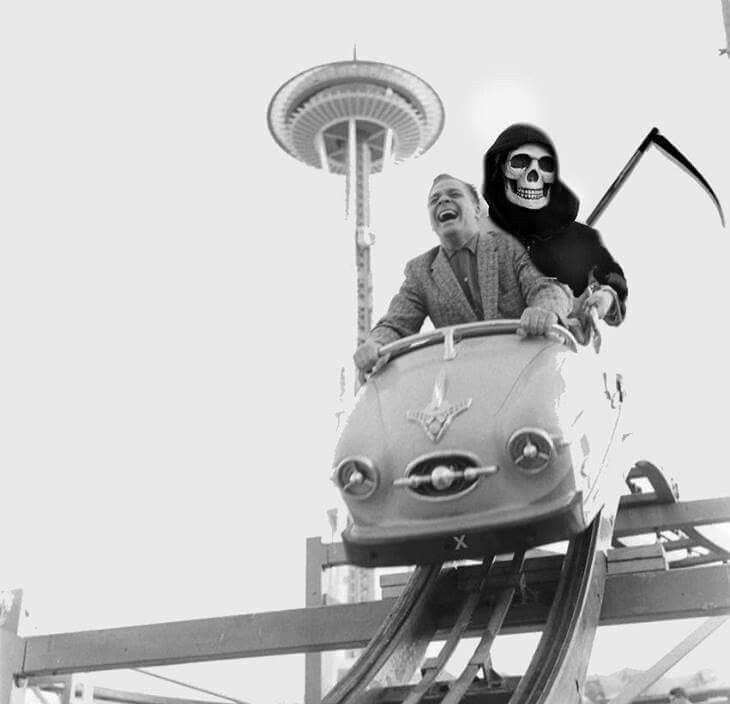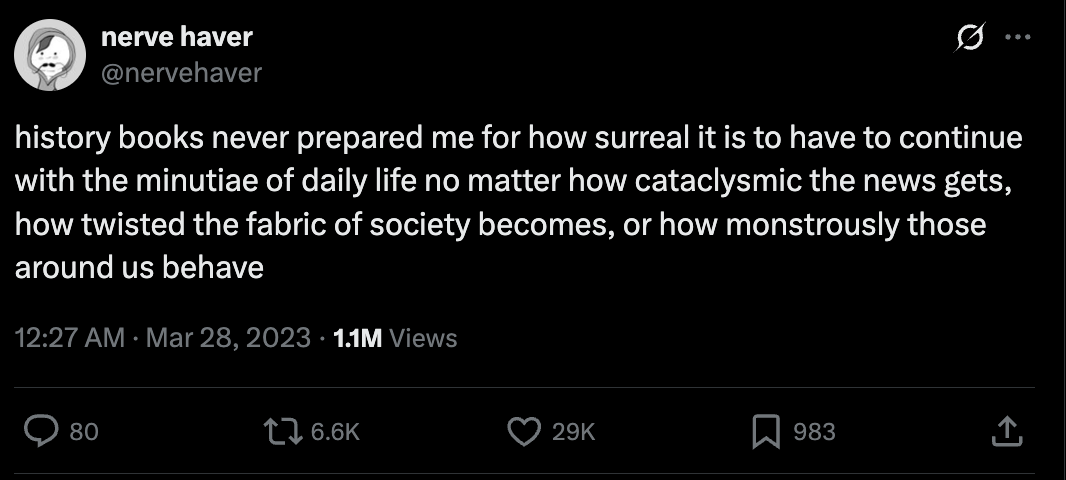Hola amigos,
Welcome back to Sunday Serendipity. This week I’m writing to you from Budapest. I flew in to spend some time with family and attend a friends wedding.
The other night, we were out at dinner and my sister brought up how she got seat 11A on the plane and felt so lucky. My parents knew exactly what she was talking about, but I was out of the loop. They told me about the Air India flight that went down earlier this month and only one person survived, he was in seat 11A.
I find it impossible to keep up with news. Especially when everyone is flooding the zone with shit and people don’t trust each other anymore. For those reasons, I’ve been keeping my social media diet light and I’m consuming less of the never ending now.
Plus social media & mainstream news has a weird vibe these days.
It seems like there’s this massive cognitive dissonance between what’s being said versus what’s being done. What we’re seeing is Hypernormalization at a grand scale.
Hypernormalization — that’s the theme of this weeks Sunday Serendipity…
Hypernormalization is when everyone lives in a system that no longer makes sense but continues acting as if it does. It isn't an entirely new concept. The idea comes from Alexei Yurchak’s book, “Everything Was Forever, Until It Was No More”.
He documents the fall the Soviet Union through the eyes of ordinary citizens living through the propaganda, pretending like everything is fine when really they know it's all so fucked. History doesn’t repeat itself, but it often rhymes.
We can study our past to try and learn from previous mistakes, yet still it’s difficult to prepare for what it feels like in the moment. Comedian Ashley Bez sums it up well:
It’s the last part that got me. Where she talks about how right next to a post about something horrible happening in the world, you'll also see an advertisement for someone selling you their AirBnB arbitrage course so you can 100x your net worth.
I'm actually shocked that we're not at the point where every ad isn't just "Buy this thing before the end of the world!" - @dailybez
If you’ve also felt the weirdness, here are a few resources I’ve found useful.
There’s an essay by Václav Havel from 1978 titled The Power of the Powerless where he explains how authoritarians stay in command through widespread participation in daily lies. His core idea is that even in a dictatorship, ordinary people have power by living in truth and refusing to play along with the lie. Havel’s essay was a guide for the peaceful resistance that turned into the Velvet Revolution in Czechoslovakia.
My guess is that by studying people like Havel and Yurchak, we can discover ways to create change in a non-apocalyptic way.
Also this 2016 documentary by Adam Curtis is fascinating and even more relevant now than when he made it. It’s long, almost three hours, but worth it.
What makes it unique is Curtis has access to all this BBC footage from his career working there and he does such a great job articulating via words and images what is happening around us now.
And the last thing I’ll leave you is this podcast from
and . These are two of my favorite thinkers when it comes to navigating the weirdness. I liked towards the end where they discuss the “draw-the-line-in-the-sand” mentality we’re seeing and how we can combat this.I agree that this yes/no binary thinking is driving so much of the weirdness. Some people seem SO convinced that their way is the right way, but maybe it’s not.
Stay curious and welcome to the Hypernormalization Club my friends.
See you next week,
<3 B
P.S. - If you enjoyed this, consider hitting the ❤️ button, it helps get the message out.






Whenever I become worried about the end of the world, I review a work of art called "The Ambassadors."
Painted in 1533 by Hans Holbein the Younger, it depicts (through symbolism) a host of crises plaguing the 16th Century world: Martin Luther's Protestant Revolution; the "Black Death" that killed half of Europe's population; the tyrannically reign of King Henry VIII; the discovery of strange and fearful new worlds; and so forth. The globe shown in the bottom half of the painting is depicted upside down, suggesting that the world had gone mad.
My point is that every generation thinks the world has gone mad and must, therefore, be near its demise. And every generation has been wrong -- so far, at least. The doomsayers and Chicken Littles will always be among us, and while we are compelled by their shrill cries and our instinctive schadenfreude to notice them, we don't really believe them. We'd rather go shopping.
Agreed, man. I keep thinking Adam Curtis is due for another one and then I think nah, he already covered this. Getting weird out there. I need to do better with the Now myself. Thanks for this!